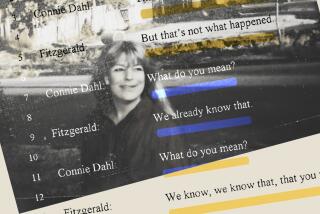After Being Duped Out of Body, Coroner Revises Rules
- Share via
When Sharon Hall and her mother were shown a photo of Jane Doe 70, their grief impressed even a coroner’s investigator, who daily unveils the dead for tearful relatives.
“They were crying, sobbing and wailing,” recalled Philip Spada, a supervising coroner’s investigator.
The women’s identification of the body as that of Hall’s sister was enough for the coroner’s office, which handles 17,000 to 20,000 bodies a year, to release it to them.
“We took her word that this was her sister,” said coroner’s investigator Ranney Pageler. “We pretty much said, ‘Sounds good. Take the body.’ ”
Thus was the coroner’s office duped out of the body of Jane Doe 70.
Body Cremated
The body eventually was cremated as part of a scheme to fake Hall’s death so she could elude creditors and probation officers in Sacramento, Santa Barbara and Mendocino counties, where she was on probation for welfare fraud and writing bad checks.
She came so close to success that she rang alarm bells in the coroner’s office, which last week drastically revised the procedures under which relatives claim the bodies of the dead.
No longer will coroner’s investigators rely solely on someone’s word in identifying a body. No longer will picking up a body be easier than claiming luggage at Los Angeles International Airport.
From now on, relatives will have to pick bodies out of a “lineup” of photos of several bodies, identify themselves with a driver’s license and be fingerprinted.
Coroner’s officials admit that the new procedures--especially having to inspect a photo collection of bodies--might upset some relatives, but the Hall case has made it necessary, they argue.
‘Trying to Catch Up’
“We don’t want people to feel like criminals, but we have to do this because of what happened,” Pageler said.
The take-no-chances response of the coroner’s office might be explained, in part, as a continuation of its efforts to overcome a long history of controversy.
The publicity-seeking former “coroner to the stars,” Thomas T. Noguchi, helped focus a spotlight--and unfavorable comment--on the office for 15 years until his demotion by the Board of Supervisors in 1982. Noguchi was accused of using the office for personal aggrandizement, loose evidence controls and allowing his private consulting work to interfere with his job.
But officials say that, through all those difficult years, there was never evidence that someone illegally made off with a body from the coroner’s office. Officials could not conceive of why anyone would try such a thing.
Bizarre Case
“I don’t think anything could get more bizarre than this one (case),” Pageler said.
The details became public July 14, when Hall and her mother, Helene Tilch, both of Fresno, were sentenced to state prison after pleading guilty to one count each of false personation. Hall, 35, received two years, and Tilch, who is 58 and wheelchair bound, got 16 months. It all began last Dec. 5 with a telephone call to coroner’s investigator Doyle Tolbert from Hall, who identified herself as Sharon Agee. “Agee” said she was looking for her sister, who she believed was dead.
“She sounded nice, very well-spoken, you know, like a concerned relative,” Tolbert said.
The investigator asked for a description of the dead woman, which Hall provided, essentially describing herself. Her height (5 feet 6 inches), hair color (brown) and general description (a heavyset white woman in her mid-30s) matched that of an unidentified body known as Jane Doe 70, unclaimed since it was discovered Oct. 25 alongside a highway in the Newhall-Saugus area, the victim of a drug overdose.
A Close Match
“She was close enough on everything to indicate there was a match,” Tolbert said.
Tolbert told her to drop by and claim the body.
When shown the photos of the body, Hall and Tilch erupted into expressions of grief that persuaded the coroner’s caretakers.
“They were good at their craft,” Spada said. “And their craft was scamming people.”
The body was cremated at a nearby mortuary under Sharon Hall’s name. Several copies of a death certificate were issued--also in Hall’s name.
Tilch mailed the death certificates to her daughter’s probation officers, according to prosecutors.
That the hoax was discovered was a tribute to the suspicions of Karen Raquel, a Sacramento County probation officer, who ordered an autopsy report on her “dead” charge.
Body Had Tattoos
The coroner’s autopsy found that the woman had had a hysterectomy and was covered with tattoos.
Raquel, who knew Hall had neither, called Los Angeles police. Police alerted coroner investigators, who took about two weeks to unravel the mystery.
The apparent ease with which Hall obtained the body has brought criticism of the coroner’s office from funeral directors, police and the Los Angeles County district attorney’s office.
“I find it hard to believe this actually occurred,” said Los Angeles Police Detective Stephen Fisk, who investigated the case.
“They (coroner’s officials) were totally incompetent,” said Deputy Dist. Atty. Rosalie Morton, who filed the charges. “They should have some rules and procedures.”
The new requirements for claiming bodies is the response, said Coroner Ronald N. Kornblum.
The office’s 37 investigators, support staff and student workers have all been briefed on the policy changes and a seven-man special operations team has been established to oversee identification of bodies, internal investigations and the computerized descriptions of all John and Jane Does, Spada said.
Medical examiners in other cities disagree on whether the new policies could prevent such a fraud, or whether they may be overkill, an unwarranted aggravation for relatives who have already gone through the trauma of searching for a missing relative.
“You can do everything you can to make it difficult, but none of those methods are foolproof,” said Roy Dames, chief administrator of the Cook County medical examiner’s office in Chicago.
Issue of Fingerprinting
Fingerprinting those who claim a body helps only in tracking someone down after it has been learned that fraud was involved, said Dames, whose office began requiring fingerprinting in the 1970s after a fake-death hoax in Chicago.
Boyd G. Stephens, medical examiner for San Francisco, said his office requires proof of identity from all of those claiming unidentified bodies.
Dental Records
“We would rather have dental records or fingerprints,” Stephens said, “as opposed to someone coming in and saying ‘That’s my sister.’ ”
But the caseload in San Francisco--about 4,000 bodies a year--is only about 20% of that in Los Angeles, and San Francisco has never encountered anything like the Jane Doe 70 case.
Even though a body might be of use to con artists in scams to escape the law or collect insurance benefits, Larry Hawkins, president of the Los Angeles County Funeral Directors Assn., said he had never heard of one being stolen during his 25 years in the business.
Although Kornblum admits that the new security measures may not be airtight, he expects them to discourage fraud.
“There’s no way that you’re going to 100% protect against something like that if you have someone who’s intent on doing it,” he said. “But you can reduce it. You can make it difficult for them.”
At the time of the release, Pageler said, employees were following long-established policies, and were glad to chalk up the case as cleared. Each year, they must bury about 100 bodies that are never identified.
When it was discovered that the “kin” were not who they claimed to be, the ashes were recovered from Tilch’s home. The remains of Jane Doe 70 were returned to the Los Angeles County coroner’s office, where they are being kept in an urn in a drawer on the chance that the unknown woman’s real relatives may turn up.
Meanwhile, the case has prompted inevitable gossip among the people drawn into it--including speculation on whether the incident was as isolated as it seems.
More to Read
Sign up for Essential California
The most important California stories and recommendations in your inbox every morning.
You may occasionally receive promotional content from the Los Angeles Times.













